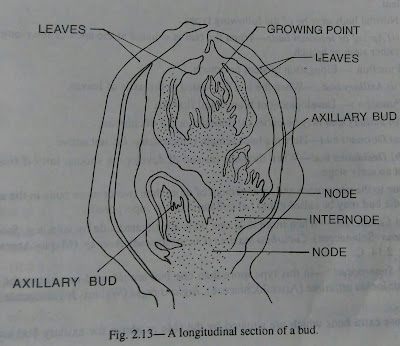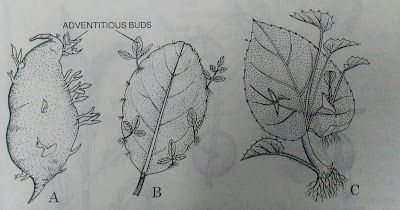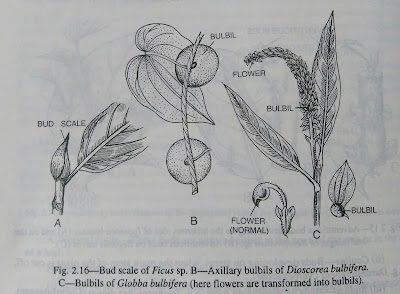The stem
Advantage and Disadvantage of Climbing Plants : The
advantage gained by climbers is mainly support. The lianes include all climbers and twiners which are linked up with their fellow supporting plants. By means of support, climbing plants can fully expose themselves to light. Lianes owing to their long intenodes and consequently of considerable length adapt themselves in various ways to their supports.
The disadvantage of the lianes is that as they are fully exposed to the light and heat of the sun, so they have chance of losing much water through transpiration.
Functions of the Stem :
I. NORMAL FUNCTIONS
(a) Mechanical function is the bearing of the crown and weight of entire plant, the production and bearing of foliage leaves,.branches and reproductive structures like flowers and fruits.
(b) Physiological function- Conduction of mineral salts and water absorbed by roots and translocation of prepared food matters to various plant parts.
II. SPECIAL FUNCTIONS-
(a) Storage of water-This is done by special water storage tissue present beneath the
epidermis of stem, as in many Cactaceae ; the best example of storing much quantity of water in the stem is afforded by the species of Echinocactus (Cactaceae) of Mexico.
(b) Storage of food (mainly carbohydrates), this is done mainly by underground modihed stems like rhizomes, tubers and corms of many plants. Sometimes the aerial stems store up starch e. g. stem of Amaranthus tricolor (Amaranthaceae).
(c) Photosynthetic function i.e. manufacture of carbohydrate food is carried out by most green stems, particularly by modified leaf-like branches or phylloclades and cladodes of Muehlenbeckia sp. (Polygonaceae) and Ruscus aculeatus'(Liliaceae).
(d) Self defence i.e. by the development of thorns and prickles-thorny and prickly stems are meant for defence against grazing animals. Examples of thorns are afforded by the species of Vangueria (Rubiaceae), Duranta (Verbenaceae), Alangium (Alangiaceae etc., prickles occur in stems of Rosa sp.
(e) Stems and branches as supporting organs-similar to the function of stems and branches as climbing organs, this is done by branch tendrils of the species of vitis (Vitaceae),
Passiflora (Passifloraceae) etc.
(f) Propagation of vegetative parts--Sub-aerial modified stems like runner, stolen, sucker and offset help in vegetative propagation and perennation.
The Bud : A bud is a condensed young shoot, in which internodes and leaves remain in a rudimentary undeveloped condition. 80 a bud has nodes and very short internodes and has a growing point ; young leaves are crowded together over a conical mass of meristem forming a bud. Brassica oleracea var. capitata (Cruciferae) is the best example of a bud.
 |
| The bud |
Kinds of Buds :
(i) Leaf bud-develops into a leaf, e.g. Ficus sp. (Momma).
(ii) Stem bud-develops into leafy branch.
(iii) Flower bud-develops into flower.
(iv) Mixed bud-develops into vegetative shoot and reproductive structure i.e. flower, e.g. Malus sylvestris (Rosaceae).
 |
| A- accessory bud, B- superposed bud, C- collateral buds |
A. Normal Buds-These buds are situated either at the apex of the axis or in the axil of a leaf.
Normal buds may be of the following types :
(i) Apical or terminal buds-When the bud is situated at the apex of the elongating axis either stem or branch.
Function :-Elongation of stem or branch.
(ii) Axillary bud :--When the bud is situated in the axils of leaves.
Function :Development of branch and flowers.
An axillary bud may be either (a) dormant or (b) deciduous.
(a) Dormant bud-Here the buds remains rudimentary i.e. not active.
(b) Deciduous bud-When the buds instead of developing shoots fall off from the plant at an early stage.
Due to the occurance and arrangement of more than two or more buds in the axil of a leaf, the bud may be called either (a) collateral or (b) superposed.
(a) Collateral r-When mom than one buds are situated side by side i.e. Solomon melongm (Solanaoeae). Cucurbita maxima (Cucurbitaceae). Acer sp. (Maple Aceraceae) etc.
(b)Superposed:--ln this type more than one bud are situated one above the other e.g. Aristolochia attissima (Aristolochiaoeae), juglans regia (Walnut Juglandaceae).
Those extra buds which are situated by side or above the axillary bud are also called accessory or supernumerary buds.
B. Adventitious Buds-Adventitious buds are those which develop from any part of the plant body except in the apex of the axis and in the axil of a leaf.
 |
| Adventitious buds |
Types of adventitious buds:
(i) Epiphyllous-Buds developing on leaves e.g. Bryopyllum calycinum(Crassulaceae), Kalanchoe spathulata (Crassulaceae) etc.
(ii) Cauline-Buds developing on stems, when the main stem of the plant is cut off. e.g. Duranta repens (Verbenaceae).
(iii) Radical-Buds developing on roots, e.g. Trichosanthes dioica (Cucurbitaceae). Cephaelis ipecacuanha (Rubiaceae), lpomoea batatas (Convolvulaceae)
Protection of Buds :
(i) By scale leaves of cataphyll types or bud-scale e.g. Artocarpus heterophyllus (Moraceae), Michelia champaca (Magnoliaceae), Ficus sp. (Moraceae) etc. Normally bud-scales protect the buds. Sometimes buds with scales are called scaly buds.
Naked bud :--bud not protected by scales.
(ii) Covered by dense hair e.g. Zizyphus mauritiana (Rhamnaceae).
(iii) Leafbase acting like a sheath-e.g. Wormia-burbizia (Dilleniaceae).
(iv) Coating of wax, cutin, oil or resinous matter to check loss of water e.g. Aesculus indica (Hippocastanaceae).
Modification of Buds and their Functions : The following special functions are carried on by the modified buds-
(i) Self defence -Hard, pointed, thorn-like structures for self defence are formed from the modified axillary bud, e.g. Duranta nepens (Verbenaceae), Alangium salvifolium (Alangiaceae) etc.
(ii) Climbing :-Apical buds are modified into tendrils for climbing purpose, e.g., Cissus quadrangularis (Vitaceae).
 |
| A- bud scale of ficus, B- axillary bulbils of Dioscorea bulbifera, C- Bulbils of Globba bulbifera |
(iii) Propagation :-Sometimes axillary buds become swollen and spherical in appcannce due to the storage of food matters. On maturity they get separated from the parent plant and fall on the ground producing new plants. Such modified buds meant for
vegetative propagation are called bulbils e.g. Globba bulbifera (Zingiberaceae), Dioscorea bulbifera (Diosconeaceae) etc.




Thanks for sharing this wonderful information. View this also - Kletterpflanzenunterstützung
ReplyDelete